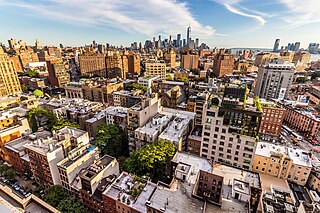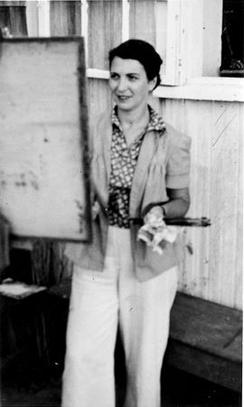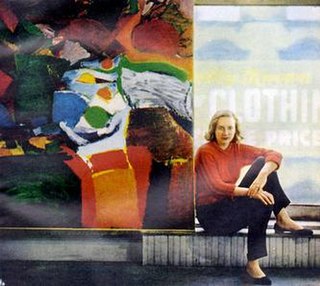Abstract expressionism is a post–World War II art movement in American painting, developed in New York City in the 1940s. It was the first specifically American movement to achieve international influence and put New York at the center of the Western art world, a role formerly filled by Paris.

Franz Kline was an American painter. He is associated with the Abstract Expressionist movement of the 1940s and 1950s. Kline, along with other action painters like Jackson Pollock, Willem de Kooning, Robert Motherwell, John Ferren, and Lee Krasner, as well as local poets, dancers, and musicians came to be known as the informal group, the New York School. Although he explored the same innovations to painting as the other artists in this group, Kline's work is distinct in itself and has been revered since the 1950s.

Elaine Marie Catherine de Kooning was an Abstract Expressionist and Figurative Expressionist painter in the post-World War II era. She wrote extensively on the art of the period and was an editorial associate for Art News magazine.
Albert Kotin belonged to the early generation of New York School Abstract Expressionist artists whose artistic innovation by the 1950s had been recognized across the Atlantic, including in Paris. The New York School Abstract Expressionism, represented by Jackson Pollock, Willem de Kooning, Franz Kline, and others became a leading art movement of the post-World War II era.

The 9th Street Art Exhibition of Paintings and Sculpture is the official title artist Franz Kline hand-lettered onto the poster he designed for the Ninth Street Show. Now considered historic, the artist-led exhibition marked the formal debut of Abstract Expressionism, and the first American art movement with international influence. The School of Paris, long the headquarters of the global art market, typically launched new movements, so there was both financial and cultural fall-out when all the excitement was suddenly emanating from New York. The post-war New York avant-garde, artists like Willem de Kooning and Jackson Pollock, would soon become "art stars," commanding large sums and international attention. The Ninth Street Show marked their "stepping-out," and that of nearly 75 other artists, including Harry Jackson, Helen Frankenthaler, Joan Mitchell, Grace Hartigan, Robert De Niro Sr., Philip Guston, Elaine de Kooning, Lee Krasner, Franz Kline, Ad Reinhardt, David Smith, Milton Resnick, Joop Sanders, Robert Motherwell, Barnett Newman and many others who were then mostly unknown to an art establishment that ignored experimental art without a ready market.
Bradley Walker Tomlin belonged to the generation of New York School Abstract Expressionist artists. He participated in the famous ‘’Ninth Street Show.’’ According to John I. H. Baur, Curator of the Whitney Museum of American Art, Tomlin’s "life and his work were marked by a persistent, restless striving toward perfection, in a truly classical sense of the word, towards that “inner logic” of form which would produce a total harmony, an unalterable rightness, a sense of miraculous completion...It was only during the last five years of his life that the goal was fully reached, and his art flowered with a sure strength and authority."
Jan Müller was a New York-based figurative expressionist artist of the 1950s. According to art critic Carter Ratcliff, "His paintings usually erect a visual architecture sturdy enough to support an array of standing, riding, levitating figures. Gravity is absent, banished by an indifference to ordinary experience." According to the poet John Ashbery, Müller "brings a medieval sensibility to neo-Expressionist paintings."
Michael Goldberg was an American abstract expressionist painter and teacher known for his gestural action paintings, abstractions and still-life paintings. A retrospective show, "Abstraction Over Time: The Paintings of Michael Goldberg", was shown at MOCA Jacksonville in Florida from 9/21/13 to 1/5/14. His work was seen in September 2007 in a solo exhibition at Knoedler & Company in New York City, as well as several exhibitions at Manny Silverman Gallery in Los Angeles. Additionally, a survey of Goldberg's work is exhibited at the University Art Museum at California State University, Long Beach since September 2010.

Nicolas Carone belonged to the early generation of New York School Abstract Expressionist artists. Their artistic innovation by the 1950s had been recognized internationally, including in London and Paris. New York School Abstract Expressionism, represented by Jackson Pollock, Willem de Kooning, Franz Kline, Conrad Marca-Relli and others, became a leading art movement of the postwar era.
Madison Fred Mitchell belonged to the New York School Abstract Expressionist artists whose influence and artistic innovation by the 1950s had been recognized around the world. New York School Abstract Expressionism, represented by Jackson Pollock, Willem de Kooning, Franz Kline and others became a leading art movement of the post-World War II era.
Ernest P. Briggs Jr. (1923–1984) was a second-generation Abstract Expressionist painter known for his expressive, sometimes calligraphic brushwork, his geometric compositions, and revolution in abstract painting that secured New York City's position as the art capital of the world in the post-World War II period.
Alfred Leslie was an American painter and filmmaker. He first achieved success as an Abstract Expressionist painter, but changed course in the early 1960s and became a painter of realistic figurative paintings.

Perle Fine (1905–1988) was an American Abstract expressionist painter. Fine's work was most known by its combination of fluid and brushy rendering of the materials and the use of biomorphic forms encased and intertwined with irregular geometric shapes.
Earl Cavis Kerkam was an American painter. According to Willem de Kooning, Philip Guston, Mark Rothko, George Spaventa and Esteban Vicente, he “was one of the finest painters to come out of America.” Gerald Norland wrote at the Earl Kerkam Memorial Exhibition in 1966:
Joe Stefanelli, also known as Joseph J. Stefanelli, belonged to the New York School Abstract Expressionist artists whose influence and artistic innovation by the 1950s had been recognized around the world. New York School Abstract Expressionism, represented by Jackson Pollock, Willem de Kooning, Franz Kline and others became a leading art movement of the era that followed World War II. He died in September 2017 at the age of 96.

Grace Hartigan was an American Abstract Expressionist painter and a significant member of the vibrant New York School of the 1950s and 1960s. Her circle of friends, who frequently inspired one another in their artistic endeavors, included Jackson Pollock, Larry Rivers, Helen Frankenthaler, Willem and Elaine de Kooning and Frank O'Hara. Her paintings are held by numerous major institutions, including the Museum of Modern Art in New York City. As director of the Maryland Institute College of Art's Hoffberger School of Painting, she influenced numerous young artists.
Robert Goodnough was an American abstract expressionist painter. A veteran of World War II, Goodnough was one of the last of the original generation of the New York School;, even though he began exhibiting his work in galleries in New York City in the early 1950s. Robert Goodnough was among the 24 artists from the total of 256 participants who were included in the famous 9th Street Art Exhibition, (1951) and in all the following New York Painting and Sculpture Annuals from 1953 to 1957. These Annuals were important because the participants were chosen by the artists themselves. Early in his career starting in 1950 he showed his paintings at the Wittenborn Gallery, NYC. He had shown at the Tibor de Nagy Gallery in New York City from 1952 to 1970 and again from 1984 to 1986. In 1960 and 1961 he had solo exhibitions at The Art Institute of Chicago. A veteran of scores of solo exhibitions and hundreds of group exhibitions in the United States and abroad, Goodnough also had solo exhibitions in 1969 at the Whitney Museum of American Art in NYC and the Albright-Knox Art Gallery in Buffalo. A major work by Goodnough is included in The Governor Nelson A. Rockefeller Empire State Plaza Art Collection in Albany, NY. In later years his paintings were also associated with the Color Field movement.
Nanno de Groot was a self-taught artist. He belonged to the group of New York School Abstract expressionist artists of the 1950s. He wrote:
In moments of clarity of thought I can sustain the idea that everything on earth is nature, including that which springs forth from a man's mind, and hand. A Franz Kline is nature as much as a zinnia.
Jane Freilicher was an American representational painter of urban and country scenes from her homes in lower Manhattan and Water Mill, Long Island. She was a member of the informal New York School beginning in the 1950s, and a muse to several of its poets and writers.
Amaranth Roslyn Ehrenhalt was an American painter, sculptor, and writer, who spent the majority of her career living and working in Paris, France before returning to New York City.





